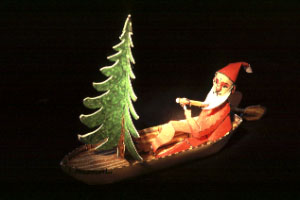
BILDRUMS JULMODELLER
Christmas models to download
Please observe that you are allowed to download
files from this page only for non-commercial personal use.
You may link to
this page, but you are not allowed to present any of BILDRUMs models as
downloadable from a cd, dvd or whatever other source including
your own or somebody elses web site.
| Christmas 2001, Art of Driving | |
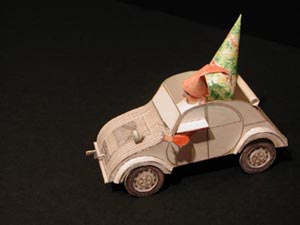 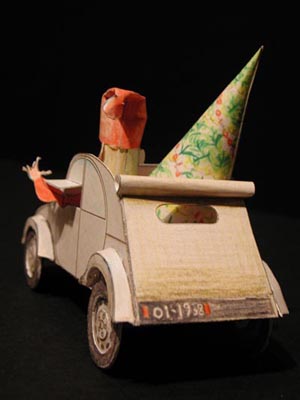 |
The model
shows how Santa brought the art of driving as a gift to mankind. It was
about the time in the late thirties when my parents fell in love with each
other. Cars were expensive things that only the very rich could afford. It
would be great, Santa thought, for people to have a vehicle for easy and
democratic transport - type "Umbrella on four wheels". I will
present my idea to Pierre Boulanger in the Citroen factory, he is the only
car manufacturer who will understand. Thought and done. "Vers Quai
Javel sur la Seine" Santa said. And off he went with the
two-reindeerpower prototype to what was later (in 1948) presented as the
2CV - the worlds most loved car. Santa said to Pierre: "This vehicle will divide the world. You will be able to see which people are good and which people are evil. Some people will love this car. They are the good ones with love, humour, ingenuity and social competence, people dreaming of a good society for all. Other people will hate this car. They are the evil ones, ignorant, egoistic, competitive and arrogant, just making a hell for others in their strive to make life better for themselves. Íf you are among the lovers, this car will be the best and most personal friend you could have when you can´t feed a horse or a reindeer to help you transport yourself and your gifts." To download the model, you need Acrobat Reader. Rightclick the picture and "save link as". The model is small, detailed and not one of the easiest to build.
Don´t forget to score all folding lines, even Santas nose and eyebrows.
There are some cuts to make before assembling: the bearings for the wheel
axles and the steering wheel axle, the center hole in the back sides of
the wheels (K), the cut under Santa´s nose and the cuts to make his feet
possible to bend into right position. |
| Note: The model is quite accurate. The 1938 prototype really had only one front lamp and no visible
outside door handles. There is a wonderful example of how this model could be motorized on Roger Pattendens web site. Have a look at http://www.heritage-models.co.uk and click on 'visit Santa' |
| Christmas 2004, art of gliding | |
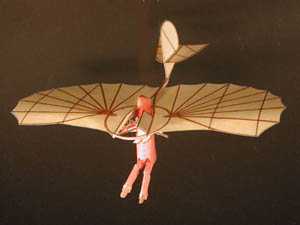 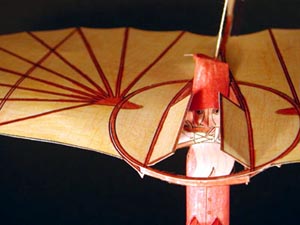 |
It was in the early 1890-ies that Santa got the idea
of presenting to mankind the art of gliding. He knew of a certain
Otto Lilienthal in Germany who together with his brother since their
youth in Vorpommern had thought a lot about birds ways of using the
air. Otto had also in 1889 published a book on the birds flight as a
ground for the art of flying. Otto Lilienthal, Santa believed, would be the right person, careful and methodical enough to carry through all those scientific experiments needed to make humans fly with the help of wings. People had tried wings since houndreds and houndreds of years. Now the time had come to give someone insight in the working forms of a wing. And someone who was also willing to tell the rest of the world how to glide through the air. Of the original gliders that Otto Lilienthal used himself, the perhaps only surviving is hanging in the ceiling of the technical museum in Warsaw. But Lilienthal also produced e series of his "Normal Segelapparat von 13 qm Segelfläche" to be sent out to other people interested in spreading the art of gliding. Some of these, the world´s first "massproduced" aeroplanes, are still preserved in museums. Lilientahl himself was killed in an accident in 1896, but his glider started a new life for mankind. Download model by rightclicking
picture and "save as".
Print on paper 120-160 g/sqm. |
| Christmas 2005, Art of Printing | |
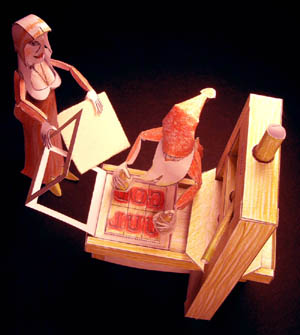 |
Santa this year got a Christmas wish from the
Brittish paper shipwright David Hathaway who wanted some light to be
spread over the the origins of the art of printing. Actually the first step on the way was to give man the ability to reflect over his own footsteps in the sand. Or was it woman getting ideas when seeing the footsteps of her man eager to walk in front of her? Whoever was the real inventor, Santa this year had to ask his wife Santy to help him. And she said: "We can do the old thing, let someone in Europe invent a technique already being used in China since houndreds of years. The chinese got the paper around the year 100, the printing around the year 600 and the loose types around the year 1000. By that time, the europeans still did not know how to make paper. But if you just give the knowlege to the right person, the europeans will learn very soon." "OK", Santa said in the mid 15th century when the europeans at last learnt how to make paper, "let us give to Johann Gutenberg in Mainz your thoughts about how to build a printing press, how to cast matrixes with the help of loose types and how to get a good ink." Said, done and within not many years, the Gutenbergs printing process was in use in all civilised european towns. I wonder if modern times have seen any technique so rapidly spread from invention to common use? |
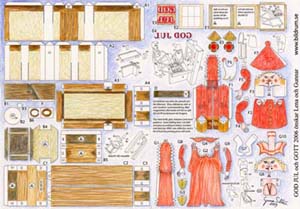 |
Download model by rightclicking picture and "save as".
Print on paper 120-160 g/sqm. Score all folding lines, even noses and eyebrows. Don´t forget the cut under the noses. Build according to letters and numbers. With a little bit of thinking, some patience, much carefulness and great luck, you could get the printing press to work. More tricky is perhaps to give Santy a nicely dressed body, but we hope just that will give you an interesting challenge.
|
| Christmas 2006, Art of Steelmaking |
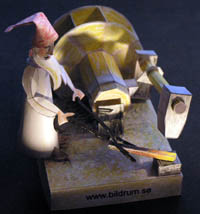 |
This year, Santa listened to the Prayers of Steel, so well
expressed by Carl Sandburg (Lay me on an anvil, O God. Beat me and
hammer me ....) and dressed up in a forgemans linen shirt. To get strength and flexibility iron must be refined through a process striving to control the contents of carbon and contaminations. This control was traditionally established by charcoal, fire and hammers. But hammers were too small and men too weak to live up to the demands of steel growing in manly minds. So "Take this hammer" Santa said one day, "and give it to the Gods of water to handle. Then you can let hammers grow to Forges - singing mothers using anvils as cradles for lumps of iron to be formed into bars of steel." It happened that Santas homeland - Sweden - besides iron ore also had rivers to give power and woods to give charcoal for the refining of the iron. People from Germany and the Netherlands settled in the swedish woods to build iron forges from the 16th century and onwards. For almost 200 years, forge iron and steel produced in Sweden totally dominated the world market. I am sad to admit though that all use of that iron and steel has not been in agreement with God and the wishes of Santa when the art of steelmaking was given to mankind. |
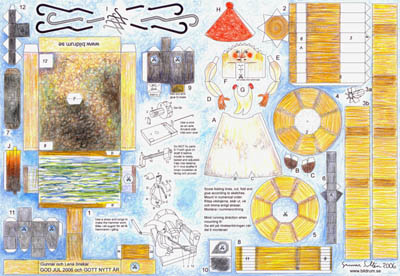 |
Download the model as a pdf-file by rightclicking the
picture to the left and "save as". Please observe that you are allowed to download files for non-commercial personal use only. You may link to this site, but you are not allowed to present any of BILDRUMs models as downloadable from your own or anybody elses web site or other media. |
| Christmas 2007, Art of Ploughing | ||
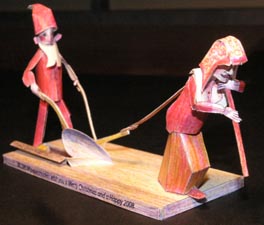 |
Santas wife Eve, also called Christmas Eve, this
year asked her husband for a new plough to give to mankind. "It
sholdn´t be one of those heavy and expesive ploughs that need lots
of animals and slaves or peasants in villenage to pull and drive.
It should be a light plow that could be built by any clever person
in the countryside with the new cheaper massproduced Brittish steels.
A light plow will produce Freedom as the peasants can leave their
landlords and clear new lands for cultivating in the woods. More
land under the plough will feed more people and more people will lay
more land under the plough. You will see that the light plow will
soon be made by factories and give food also to all their workers.
The light plough will not only give freedom. It will also give
industrialisation and wealth to mankind." |
|
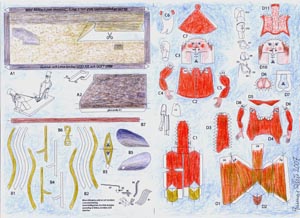 |
Download the model as a pdf-file by rightclicking the
picture to the left and "save as". Please observe that you are allowed to download files for non-commercial personal use only. You may link to this site, but you are not allowed to present any of BILDRUMs models as downloadable from your own or anybody elses web site or other media.
|
| Christmas 2008, Art of Digitising | ||
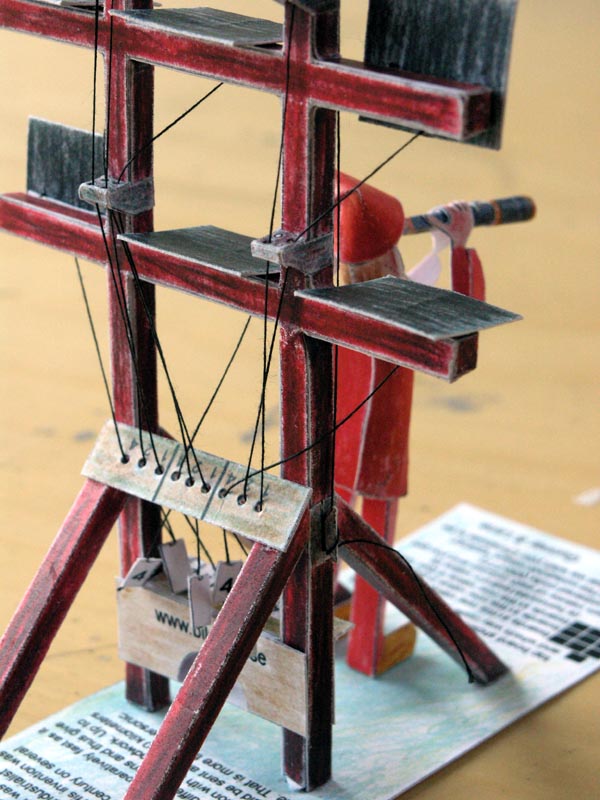 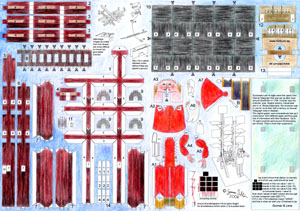 |
Far back in 1794, Santa asked his wife Christmas
Eve about ideas for gifts to Mankind. And Eve said: "Mathematics must be
fun. Have you ever thougt of all those people around the world
who are trying to telegraph messages over long distances with the help of flags,
semaphores and all sorts of curious constructions. Why not give that genious scientist, poet, theatre director and industrialist
Niclas Edelcrantz in Stockholm
the idea that binary mathematics could be combined with the digital insight
that a switch that has only two precise places, on or off, has less chances
to be misunderstood than any other means giving more opportunities." Download the model as a pdf-file by rightclicking the
picture to the left and "save as". |
|
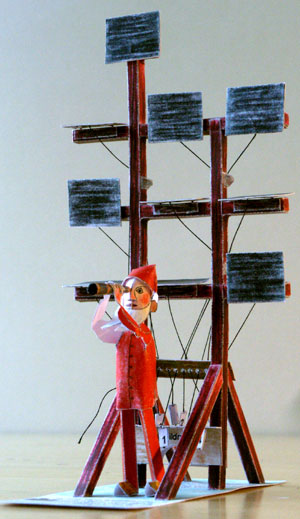
|
Top board shows when station is manned and which way
code should be read. Showing boards in upper row value 1 (bin 1) Showing boards in middle row value 2 (bin 10) Showing boards in bottom row value 4 (bin 100) (not showing boards value 0) Sum down values of each individual column and you get a three numbered code (000-777) 215 in the 1794 codebook meant "GOOD", |
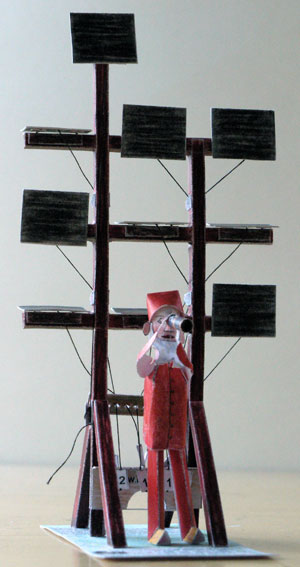
|
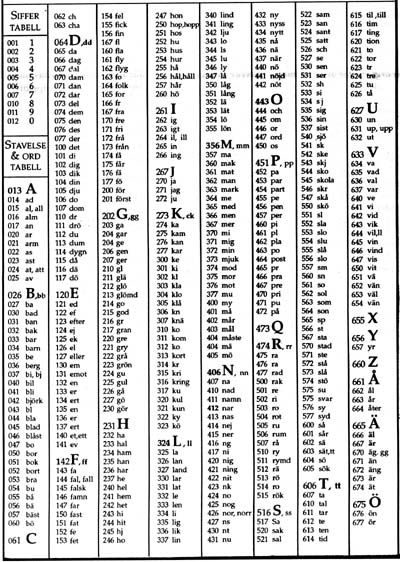 If you want the historical table of signs for the digital telegraph, click the picture above. |